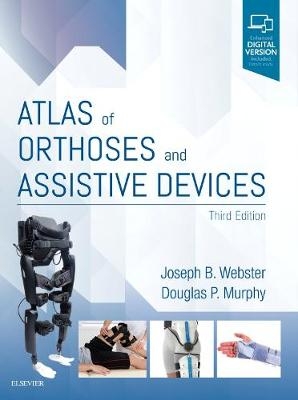
Atlas of Orthoses and Assistive Devices
Elsevier - Health Sciences Division (Verlag)
978-0-323-48323-0 (ISBN)
Provides an introduction to Brain-Computer Interface (BCI) systems relating to Assistive Technology (AT) systems and orthotics.
Includes Key Points in every chapter so you can quickly access expert guidance.
Maintains a valuable balance of content that is essential for both physiatrists and orthopaedic surgeons.
Covers state-of-the-art topics in the areas of biomechanics, fabrication techniques, and construction of orthoses with advanced technologies.
Incorporates an all-new, vibrant full-color design to enhance illustrations and make navigation fast and easy.
Places greater emphasis on carbon fiber materials and lightweight thermoplastics.
Includes content on 3D printing technology and how it has revolutionized fabrication strategies.
Features a more in-depth discussion of sensors and microprocessor technologies, advances in FES technology with respect to orthotics, smart devices and relevant apps, and the use of scanner technology in orthotic fabrication.
Explains new orthotic devices and their indications from acute traumatic situations through chronic rehabilitation needs.
Expert ConsultT eBook version included with purchase. This enhanced eBook experience allows you to search all of the text, figures, and references from the book on a variety of devices.
Dr. Douglas Murphy is a highly respected Medical Director of the Regional Amputation Center Hunter Holmes McGuire VA Medical Center in Richmond VA. Co-editor of our key text on 'Atlas of Orthoses and Assistive Devices', Dr Murphy is an expert in the field of robotic rehabilitation. His research interests include Brain Computer Interface and Prosthetics, Amputee Gait Deviations, Telemedicine, Prosthetics, and EMG.
Section 1. Basics
Section 1 Introduction
1. The Orthotic Prescription
2. Materials Science
3. Principles of Fabrication
4. Principles of Normal and Pathologic Gait
Section 2. Spinal Orthoses
Section 2 Introduction
5. Biomechanics of the Spine
6. Principles and Components of Spinal Orthoses
7. Orthoses for Spinal Pain
8. Orthoses for Spinal Deformities
9. Orthoses for Spinal Trauma and Postoperative Care
10. Orthoses for Osteoporosis
Section 3. Upper Limb Orthoses
Section 3 Introduction
11. Biomechanics of the Upper Limb
12. Principles and Components of Upper Limb Orthoses
13. Upper Limb Orthoses for the Stroke and Brain-Injured Patient
14. Upper limb Orthoses for Persons with Spinal Cord Injury and Brachial Plexus Injuries
15. Orthoses for the Burned Hand
16. Orthotic Considerations for Arthritis and Overuse Syndromes in the Upper Extremity
17. Functional Bracing of Selected Upper Limb Fractures
Section 4. Lower Limb Orthoses
Section 4 Introduction
18. Biomechanics of the Hip, Knee, and Ankle
19. Foot Biomechanics
20. Shoes and Shoe Modifications
21. Foot Orthoses
22. Lower Limb Orthoses
23. Lower Limb Orthoses for Persons with Spinal Cord Injury
24. Orthoses in Total Joint Arthroplasty
25. Knee Orthoses for Sports-Related Issues
26. Orthotic Management of Neuropathic and Dysvascular Feet
27. Orthotic Management of Polio and Postpolio Syndrome
28. Lower Limb Orthoses for Persons Who Have Had a Stroke
29. Assessment and Orthotic Management of Gait Dysfunction in Individuals with Traumatic Brain Injury
Section 5. Pediatric Orthoses
Section 5 Introduction
30. Congenital and Acquired Disorders
31. Pediatric Hip Orthoses
32. Orthoses for the Muscle Disease Patient
33. Orthoses for Cerebral Palsy
34. Orthoses for Myelomeningocele
35. Cranial Remolding Orthoses
Section 6. Assistive Devices
Section 6 Introduction
36. Canes, Crutches, and Walkers
37. Wheeled Mobility: Evaluation for Orthotic Seating and Positioning
38. Wheeled Mobility: Device Prescription and Care
39. Wheelchair and Assistive Device Considerations for Remote Settings
40. Communication Devices and Electronic Aids
41. Sports Adaptations and Assistive Devices for Recreation
42. Driving and Related Assistive Devices
43. Neuromuscular Stimulation
44. Exoskeletal Assisted Rehabilitation after Spinal Cord Injury
45. Future Trends and Research in Orthoses
| Erscheinungsdatum | 06.02.2018 |
|---|---|
| Zusatzinfo | 1100 illustrations (600 in full color); Illustrations |
| Verlagsort | Philadelphia |
| Sprache | englisch |
| Maße | 216 x 276 mm |
| Gewicht | 1430 g |
| Themenwelt | Medizin / Pharmazie ► Physiotherapie / Ergotherapie ► Orthopädie |
| Medizin / Pharmazie ► Physiotherapie / Ergotherapie ► Rehabilitation | |
| Technik ► Medizintechnik | |
| ISBN-10 | 0-323-48323-2 / 0323483232 |
| ISBN-13 | 978-0-323-48323-0 / 9780323483230 |
| Zustand | Neuware |
| Haben Sie eine Frage zum Produkt? |
aus dem Bereich


